1 X Slots
In a previous blog post, we covered the difference between PCI and PCI-X. The response to the post was enthusiastic, and we were asked to write a complementary post explaining the difference between PCIe x1, x4, x8, x16. We are always happy to answer customers’ questions (feel free to contact us with your questions regarding industrial computers).
10 x Black PCI Chassis Slot Covers Bracket with Screws Blanking Plate hH. 5pcs Mesh PCI Bracket Slot Cover Dust Filter Screws Blanking Plate Black Useful. $6.99 previous price $6.99. Dual 2.5' SSD SATA HDD To 3.5' Inch Mounts Adapters Hard Drive Bracket For PC. Choose from our selection of T-slots, including T-slotted framing rails, T-slotted framing structural brackets, and more. In stock and ready to ship. Receive a 100% 1 X Agp 4x Slot match on your first deposit at Casimba, all the way up to £500! You will also receive 50 free spins to enjoy. You will also receive 50 free spins to enjoy. Permanent Wager: x50 Min deposit: €20. Play the most realistic slots! Free slots with large smoothly animated reels and lifelike slot machine sounds.
The short answer is:
- ‘PCIe x1’ connections have one data lane
- ‘PCIe x4’ connections have four data lanes
- ‘PCIe x8’ connections have eight data lanes
- ‘PCIe x16’ connections have sixteen data lanes
The long answer:


The more data lanes in a connection, the more bandwidth between the card and the host. However, there is usually a cost increase incurred with higher lane counts.
PCIe is an updated version of the PCI protocol. Similar to PCI/PCI-X interfaces, PCIe was developed for peripheral component interconnection. PCIe differs from PCI/PCI-X in several ways, but this blog won’t cover most of those differences. However, one key difference will allow us to better understand the differences between the variations of the PCIe protocol (x1, x4, x8, x16 and x32). That key difference is ‘parallel’ versus ‘serial’ data transmission.
In PCI and PCI-X architecture, all of the cards share parallel data lines to and from the host. Differences between card-speeds and slot-types regularly result in throttled data speeds.
In the PCIe architecture, Each card has it’s own dedicated serial data connections (lanes) to the host. This allows each card connection to achieve a bandwidth independent of other cards that may be active in the system. The number of lanes are indicated by the suffix of the PCIe protocol (×1, ×4, ×8, ×16, ×32). Each lane is capable of speeds from 250-1969 MB/s, depending on the version of the PCIe protocol (v1.x, v2.x, v3.0, v4.0).
PCIe cards can always operate in PCIe slots with the same or more lanes than the card. For example, an x8 card can operate in a slot with x8, x16, or x32 lanes. Similarly, an x1 card can operate in any PCIe slot.
caveat:
Sometimes, a PCIe slot operates with fewer data lanes than the mechanical slot-type indicates. For example, sometimes a motherboard manufacturer will use an x16 mechanical slot even though the data connection is only x8. In these cases, the higher-bandwidth card still may work (for example, an x16 card in an x16 slot with only x8 connection), if the card doesn’t require that extra bandwidth. The following image shows the PCI connections of the motherboard used in DuroPC’s RAC355. Notice ‘SLOT 1/5’ are PCIe x16 slots but only have an x8 connection. Similarly, notice how ‘SLOT 7’ uses an x8 slot but only has an x4 connection. (Click the image to see a larger version.)
# Introduction
Laravel Livewire is a library that makes it simple to build modern, reactive, dynamic interfaces using Laravel Blade as your templating language. This is a great stack to choose if you want to build an application that is dynamic and reactive but don't feel comfortable jumping into a full JavaScript framework like Vue.js.
When using Livewire, your application's routes will respond with typical Blade templates. However, within these templates you may render Livewire components as necessary:
1xslot Apk
When using the Livewire stack, Jetstream has some unique features that you should be aware of. We will discuss each of these features below.
Livewire Documentation
Before using the Livewire stack, you are strongly encouraged to review the entire Livewire documentation
# Components
When we created the Jetstream Livewire stack, a variety of Blade components (buttons, panels, inputs, modals) were created to assist in creating UI consistency and ease of use. You are free to use or not use these components. However, if you would like to use them, you should publish them using the Artisan vendor:publish command:

You may gain insight into how to use these components by reviewing their usage within Jetstream's existing views located within your application's resources/views directory.
# Modals
Most of the Jetstream Livewire stack's components have no communication with your backend. However, the Livewire modal components included with Jetstream do interact with your Livewire backend to determine their open / closed state.
1 X Slots Casino
In addition, Jetstream includes two types of modals: dialog-modal and confirmation-modal. The confirmation-modal may be used when confirming destructive actions such as deletions, while the dialog-modal is a more generic modal window that may be used at any time.
To illustrate the use of modals, consider the following modal that confirms a user would like to delete their account:
1 X Pcie 3.0 X16 Slots
As you can see, the modal's open / close state is determined by a wire:model property that is declared on the component. The property's name should correspond to a boolean property on your Livewire component's corresponding PHP class. Typically, you will set this property to true when the user clicks a UI element in your application that should open the modal. Of course, the property should be set to false when you are ready to close the modal.
1 X Slot Casino
The modal's contents may be specified by hydrating three Blade component slots: title, content, and footer.